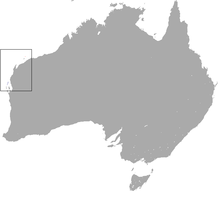| Rufous hare-wallaby[1] | |
|---|---|

| |
| Scientific classification | |
| Domain: | Eukaryota |
| Kingdom: | Animalia |
| Phylum: | Chordata |
| Class: | Mammalia |
| Infraclass: | Marsupialia |
| Order: | Diprotodontia |
| Family: | Macropodidae |
| Genus: | Lagorchestes |
| Species: | L. hirsutus
|
| Binomial name | |
| Lagorchestes hirsutus Gould, 1844
| |

| |
| Rufous hare-wallaby range (blue — native, red — introduced) | |
The rufous hare-wallaby (Lagorchestes hirsutus), also known as the mala, is a small macropod found in Australia. It was formerly widely distributed across the western half of the continent, but naturally occurring populations are now confined to Bernier Island and Dorre Island Islands off Western Australia.[4]
Although once widespread in the central and western deserts, predation by feral cats and foxes, and destructive wildfires, caused the last wild population on mainland Australia to go extinct in the early 1990s.[5] Despite its extinction in the wild, the mainland subspecies persisted in captivity.[6]
The species, which is currently classified as vulnerable,[2] has rufous-grey fur and is the smallest hare-wallaby, weighing just 800-1,600 grams.[5] It is a solitary nocturnal herbivore that feeds on herbs, leaves and seeds.
Mala prefer spinifex sandplain habitat; the animals build burrows under large spinifex hummocks. The burrows are tunnel-like structures with a spinifex roof. This provides a cool refuge during the heat of the day. In summer, they are likely to dig deeper burrows to withstand searing desert temperatures.[5]
Captive stocks of the mainland subspecies are currently being reintroduced in the Tanami Desert in the Northern Territory.[4] In July 2019, the first reintroductions into the Newhaven Sanctuary were conducted, with the release of 30 individuals into the 9,400 hectare, feral predator-free area.[5]
Animals from both Bernier Island and Dorre Island have recently been translocated to Dirk Hartog Island following the complete removal of livestock and feral cats from the landscape.[7]
- ^ Groves, C. P. (2005). Wilson, D. E.; Reeder, D. M. (eds.). Mammal Species of the World: A Taxonomic and Geographic Reference (3rd ed.). Baltimore: Johns Hopkins University Press. p. 63. ISBN 0-801-88221-4. OCLC 62265494.
- ^ a b Burbidge, A.A.; Woinarski, J. (2016). "Lagorchestes hirsutus". IUCN Red List of Threatened Species. 2016: e.T11162A21954429. doi:10.2305/IUCN.UK.2016-2.RLTS.T11162A21954429.en. Retrieved 13 November 2021.
- ^ "Appendices | CITES". cites.org. Retrieved 2022-01-14.
- ^ a b Menkhorst, Peter (2001). A Field Guide to the Mammals of Australia. Oxford University Press. p. 108.
- ^ a b c d "Restoring Australia's lost biodiversity to the central deserts". 4 December 2019.
- ^ "Department of Agriculture, Water and the Environment". Department of Agriculture, Water and the Environment. Retrieved 2020-09-03.
- ^ "Threatened species introduced to Dirk Hartog Island National Park - Parks and Wildlife Service". www.dpaw.wa.gov.au. Retrieved 2020-09-03.
